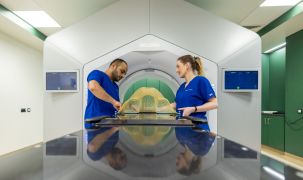Radiotherapy
Contact Us
Request an AppointmentPlease note that a referral letter is required before an appointment can be confirmed.
Please note that a referral letter is required before an appointment can be confirmed.
About radiotherapy
Radiotherapy, also called radiation therapy, is a highly targeted, highly effective way to destroy cancer cells. Radiotherapy uses high-energy rays to damage cancer cells and stop them from growing and dividing.
It is a localised treatment which aims to destroy the cancer cells with as little damage as possible to the surrounding normal or healthy cells.
Radiotherapy is used to treat and cure cancer; it is often referred to as curative radiotherapy. In other cases it is used to control symptoms caused by the cancer, known as palliative radiotherapy.
There are a number of treatment types and delivery methods. Treatment can be delivered via external beams from an x-ray like machine (external radiotherapy) or via devices or implants placed inside the patient (internal radiotherapy or brachytherapy).
Radiotherapy can be delivered in many different ways from outside (externally) or inside (internally) the body.
- External radiation therapy: known as external beam radiotherapy, is delivered from a machine known as a linear accelerator. It is usually given on an outpatient basis in a hospital or clinic, five days a week for a number of weeks.
- Internal radiation therapy: known as brachytherapy, is a method used to deliver high dose radiation to a small volume of tissue. It can come in the form of a temporary or permanent implant. Depending on the type of cancer, it will require a short stay of a few days in hospital or can be performed as an outpatient procedure.
With radiotherapy, the side effects depend on the treatment dose and the part of the body that is treated. The most common side effects are:
- Tiredness
- Skin reactions in the area being treated (such as a rash or redness, permanent pigmentation, and scarring)
- Loss of appetite
- Inflammation of tissues and organs
External beam radiotherapy
External beam radiotherapy is the term used to describe radiotherapy that is delivered using machines called linear accelerators, by a team of radiation therapists.
Procedure
The treatment takes place inside a special treatment room which you will be inside for ten to fifteen minutes.
Once inside the room, you will need to remove or loosen your clothing and lie on a treatment couch.
The linear accelerator is similar to a large x-ray machine. Three-dimensional (3D) conformal radiation therapy is a technique whereby the beams of radiation used in treatment are shaped to match the tumor. Such advances in imaging technology have made it possible to locate and treat the tumor more precisely.
The radiation therapists will align you with the treatment machine and may take x-ray images to assist with this process.
When the radiation therapists have completed the set-up process, they will leave the room to switch on the treatment machine. When the machine is switched on you will hear a humming or buzzing noise. You should lie still and breathe normally while the radiation beam delivers your treatment. It is a painless procedure.
This treatment is generally carried out Monday - Friday, for a period of seven weeks.
Intensity modulated radiation therapy (IMRT) is a specific type of external beam radiotherapy that shapes the radiotherapy beams to the exact size and shape of the area being treated.
Not only does it match the shape of the area being treated, but it also matches the dose to the area being treated.
Advanced technology allows different doses of radiotherapy to be given to different parts of the treatment area. This is very useful in ensuring that the affected area receives the optimum dose required, while sparing the healthy surrounding tissue and reducing the risk of injury to nearby organs.
Image guided radiotherapy therapy (IGRT) is technological advancement in external beam radiotherapy.
Prior to the planning scan, tiny gold markers are implanted into the prostate. The radiation therapists image these markers prior to each treatment, so the treatment beam is accurately aligned to the exact treatment area.

The Varian Halcyon™
The Latest Innovation In Radiotherapy Treatment Systems is now available in Limerick.
Learn moreBrachytherapy
Radiation can be given internally or externally. When radiotherapy is given internally, it is called brachytherapy. Treatment may be in the form of an implant (eg radioactive seed implantation for prostate cancer) or using a source (eg catheter) which is placed in or near the tumour itself. Brachytherapy is localised, precise and a high-tech treatment. A number of brachytherapy treatments are carried out in the radiotherapy department in Dublin and our consultants can discuss the treatment options with you locally.
There are two types of brachytherapy treatment available: low-dose rate and high-dose rate.
High-dose rate (HDR) brachytherapy is a type of internal radiotherapy that delivers radiation from implants placed close to, or inside, the tumour in the body. This is mainly used to treat cancers in the head and neck area, the cervix, womb, prostate or the skin.
Prostate cancer
For patients with prostate cancer at an advanced stage, high dose rate (HDR) brachytherapy is used to deliver a very high radiation dose boost to the prostate. This is normally prescribed in combination with a course of IMRT external beam radiotherapy.
The process involves implanting several needles into the prostate under ultrasound guidance.
A patient will first have a CT scan with the needles in place. The exact position of each needle and the organs in close proximity, are mapped out.
Following careful planning, the needles are attached to a treatment machine where a radioactive source is automatically pushed into each needle where it remains for just a few moments.
The implanted needles are removed following the treatment and no radioactivity remains in the patient.
This involves placing radioactive seeds directly into your tumour and leaving them permanently in place. In Ireland, LDR brachytherapy tends to be used for treating men with prostate cancer. This treatment is commonly known as radioactive seed implantation (RASI).
Radioactive seed implantation
Mater Private Dublin was the first hospital in Ireland to introduce prostate seed brachytherapy. It is particularly suitable for patients whose prostate cancer is in the earlier stages.
The process involves the surgeon implanting up to 90 radioactive seeds into the prostate in carefully planned positions. The positioning of these seeds is determined using a combination of ultrasound images and advanced software, which updates the position of each seed as it is implanted and re-calculates the dose based on the actual position of seeds. This is called ‘real-time’ planning, and it allows the surgeon to modify and correct the delivery of the treatment to ensure the best possible outcome.
The radioactive seeds used are I - 131. These release radiation over a very small distance, allowing a sufficient dose to be given to the prostate while significantly protecting the surrounding healthy organs of the rectum and bladder from any damage. The seeds are left in place permanently and their radioactivity diminishes over time.
Stereotactic body radiation therapy (SBRT)
Stereotactic body radiation therapy (SBRT) uses advanced radiation-delivery equipment combined with imaging technology to deliver high doses of radiation with pinpoint accuracy. This therapy is most commonly used to treat certain types of lung tumours that cannot be removed safely with surgery, and is also highly effective on tumours in the prostate, liver, spine, pancreas, and abdomen.
Stereotactic radiosurgery (SRS) uses highly focused, highly accurate x-ray beams to deliver a large dose of radiation in a single treatment, made possible by new imaging capabilities that allow precise and accurate set-up without the use of an invasive head frame. SRS is used to treat small brain and spinal cord tumours and certain blood vessel abnormalities.
Surface guided radiation therapy (SGRT)
Surface guided radiation therapy (SGRT) is a radiotherapy technique designed to improve the accuracy of patient treatment. During the treatment, a camera shines a red speckled pattern on the body surface of the patient to monitor exact positions for precisely targeted radiation. This process ensures that the treatment area receives the maximum dose of radiation therapy while the surrounding healthy tissue receives a much lower dose.
The SGRT system allows for a reduction in the number of tattoos given to patients, as the exact planned positions can be reproduced by the SGRT cameras. This system allows for real-time monitoring of patient position so if the patient moves during treatment, the radiation can automatically be paused until they are back in the planned position.
Xofigo (Ra223 dichloride) radionuclide therapy
Ra223 (Xofigo) is used in the management of locally advanced prostate cancer. Xofigo has been shown to extend overall survival and quality of life, while also extending the time to the first adverse event resulting from the bone disease. Xofigo comes in the form of a ready-to-use liquid which is administered to the patient through an intravenous injection every four weeks for a total of six injections.
Radium-223 has similar characteristics to calcium and as a result is rapidly taken up in areas of bone growth (i.e. cancer cell growth). As an alpha-emitter, the therapeutic action of Xofigo treatment is extremely localised, spreading only a few cell diameters within the cancer cells in the bones. This results in the treatment being highly targeted at the cancer cells whilst minimising damage to surrounding healthy tissue.
Frequently asked questions
The radiation you receive delivers its dose to the treatment area instantaneously. There is no lingering radiation once the treatment machine is turned off. If you are treated with external beam radiation, you will not be radioactive at any time.
Radiotherapy is a “local” treatment, which means it is directly focused on just the affected area. Therefore patients will only lose hair in that area. Unless radiation is targeted at your head, you will not lose your hair from the treatment.
Radiotherapy may cause a sensation of feeling sick or vomiting if your abdomen or pelvic area is being treated. You will be advised if this is a possible side effect of your particular treatment, and appropriate medication will be prescribed if necessary.
Radiotherapy is the careful use of invisible high-energy x-rays to treat cancer and does not involve the use of radium.










/dr.-daniel-cagney.png?sfvrsn=8fbe04f_1)
/dr.-jerome-coffey-.png?sfvrsn=ddd8bd63_1)
/dr.-anne-gribbin-.png?sfvrsn=1b7f2f70_1)
/dr.-richard-moore-.jpg?sfvrsn=2e0c4505_1)
/dr.-brian-o'neill-.jpg?sfvrsn=b68af355_1)
/mazen-el-bassiouni-240-x-240.jpg?sfvrsn=fd0d68ea_1)
/dr-greg-korpanty-(240-x-240).jpg?sfvrsn=6d0991e5_1)

